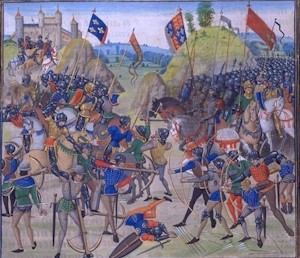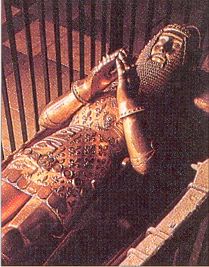|
|
|
|
|
|
|
| Periods | Kings | Maps |
Pictures | Gaming info |
|
| HOMEPAGE | |
| The fourteenth and fifteenth centuries were a time of great upheaval for medieval France. In 1328 the Capetian line came to an end. This was the trigger for the Hundred Years War as successive English kings attempted to uphold their claim to the French throne. Catastrophic defeats at Crécy and Poitiers shook the French kingdom to its core. A period of respite followed under Bertrand du Guesclin, but an even more devastating assault was to follow, under the warrior-king par excellence Henry V, and the French disintegration continued until 1429. After that date the French began a recovery, partly triggered by the young visionary Joan of Arc, that would end with them as the major European military power. |
|
|
|
RESOURCES |
NOTES FROM THE AUTHOR - Last updated
30-July-2002:
This web site is currently undergoing a major redevelopment. Its initial purpose was to be a supplementary part of my Medieval Total War site, but it appears that it is receiving more interest than I had anticipated. I therefore think, to do the subject justice, I need to add a little more information on it.
|
| | UNI OF KANSAS SUMMARY | | |
| | GENERAL INFO | | |
| | THE FINAL PHASES | | |
| | USEFUL LINKS | | |
| | ANOTHER GOOD SITE | |
100 Years' WarTimeline |
|
| 1328:
Charles IV dies, ending
the Capetian dynasty. Philip of Valois succeeds him as Philip VI.
1329: Edward III of England does simple homage for Aquitaine (Guienne), but refuses to do liege homage. 1336: Edward places an embargo on English exports of wool to Flanders. 1337: Philip declares Edward's fiefs forfeit and begins harassing the frontiers of Aquitaine. 1338: Edward III formally claims the French crown. 1346: Battle of Crécy 1356: Battle of Poitiers 1358: The Jacquerie 1360: Peace of Brétigny 1369: Renewed fighting in France. 1370: French troops commanded by Bertrand du Guesclin. 1381: Peasants' Revolt in England 1392: Charles VI of France suffers his first attack of insanity. Conflict between the Armagnacs and the Burgundians begins. 1399: Henry of Lancaster seizes English throne, becoming Henry IV. 1415: Henry V wins a great victory over the French at Agincourt. 1420: Treaty of Troyes 1429: Joan of Arc relieves the siege at Orléans. 1431: Joan burned at the stake at Rouen. 1435: Peace of Arras; Burgundy abandons the English. 1436: Charles VII captures Paris. 1453: Bordeaux falls to the French. The war ends without a treaty. |
|
|
Redevelopment plan for web site |
Periods Battles Kings Maps Pictures Timeline Gaming info |
 |
 |
Edward (The Black Prince) |
| While Edward the 'Black Price' clearly
inherited his father's military virtues, he lacked Edward III's
humanity. His gilded tomb in Canterbury Cathedral represents him as
a paragon of chivalry - which he was but although brave in battle and a
good general, he failed as a ruler in Aquitaine (1362-72). The
disastrous resumption of the war after 1369 was a direct result of his
harsh taxation following the great expense of the Castilian expedition.
|